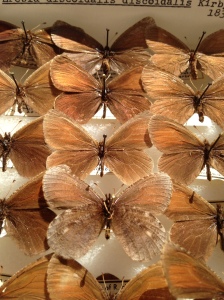
Robert Michael Pyle’s “Handbook for Butterfly Watchers” is a must-have for anyone wishing to improve their butterflying skills
I just finished reading Robert Michael Pyle’s beautiful 2010 book, Mariposa Road: The First Butterfly Big Year. I’ve been a fan of Pyle’s writings for a while, and his Handbook for Butterfly Watchers is high on my recommendation list for people who want to expand their butterflying skill. Unfortunately I haven’t had much time for reading lately, so I’ve been sneaking little bites of Mariposa Road for months now- a trip to Texas here, a break in the Florida Keys there. I finally finished it, and now I’m pondering the idea of a Big Year.
A bit of background: The Big Year concept was first popularized by birders. A Big Year is an attempt by one person to count as many species as possible in one calendar year in a proscribed area, usually the U.S. (the specific “rules” have changed since the earliest days of Big Years). I first learned about the Big Year concept by reading Kenn Kauffman’s wonderful Kingbird Highway, and later followed it up with Mark Obmascik’s The Big Year: A Tale of Man, Nature, and Fowl Obsession. And yes, that last one was turned into a movie starring some folks you’ve probably heard of. Kauffman himself was famously inspired by Roger Tory Peterson and James Fisher’s 1955 Wild America.
Pyle’s book documents the first-ever verified butterfly Big Year, undertaken by him in 2008. Pyle’s Big Year was not some random butterfly watcher’s vain and selfish endeaver- Pyle has long been an important champion of butterfly conservation, and he used his Big Year as a fundraiser for the Xerces Society (which, by the way, he also founded). As always, his writing is lyrical, funny, and informative. One of the benefits of reading it in short chunks the way that I did is that each time I picked it up, I was inspired anew by his love of butterflies, and that pleasure was spread out over months.
One common criticism of Big Year attempts, similar to criticisms of speed records on the Appalachian Trail, is that there is little time to appreciate the ordinary, every day aspects of the endeavor, and barely time to revel in the joy of the exceptional. Pyle blasts that line of criticism to smithereens. He clearly states at the outset that familiarity most certainly will NOT breed contempt, and the reader doesn’t have to get very far into the book to enjoy Pyle’s own appreciation of the common species. My favorite bits, though, come from his delight in the inconspicuous or unassuming species. Take Erebia discoidalis, the Red-disked Alpine: “On this kind, the cinnamon scales smear all over the chocolate above. Below, the subtle but intricate mix brought to mind rust and cloud on peat and loam.” Most folks upon encountering this butterfly wouldn’t have noticed it; most who did would mistake it for a drab moth, wondering why it was out and about in the daytime if they even gave it a second thought. Pyle, though, manages to find beauty in it, and to make the reader share in that finding, as well.
I’ve known birders who have done a Big Year and I can’t deny that they have some amazing stories and see some incredible things. The idea of doing a Big Year certainly has some appeal. But I could never quite imagine making the time commitment that a Big Year requires. It might sound like a wonderful way to see the country, but I’ve done field work. I know how time consuming it is. I know how easy it is to not really see the land around you when focused on a daunting task like this. And I know myself, and I wonder if I would really be able to drink it all in, the way Pyle manages to do in between sleep deprivation and road food. I don’t know if a Big Year is for me, but I’ve been thinking a lot lately about a modified Big Year. There are lots of way to reduce the scope of a Big Year, either geographically or temporally, in a way that still leaves time for work, family, and recreation.
How can you modify a Big Year? You can do a Big Month. Or even a Big Day. You could modify the geographic parameters- what about a County Big Year? For a birder in Los Angeles that’s something like 500 species of birds possible (feel free to correct me on that in the comments if my number is off. I was never a great west coast birder). For a butterflyer in Los Angeles, the number of possibilities is ~145. That’s still a pretty significant challenge! You can do your (modified) Big Year as part of a larger effort, contributing data to eButterfly, eBird, the annual NABA count or Christmas Bird Count; you can turn it into a fundraiser for your local Audubon group; or have the nerdiest competition ever with your friends.
But whatever you do, remember to take time to appreciate the common species, and to find beauty and wonder everywhere you look. And as Pyle says, “Then slow down, and let the butterflies lead. You’ll see just as many as you see; and much more besides.”


Pingback: Back East Backyard Big Year | Chasing Checkerspots